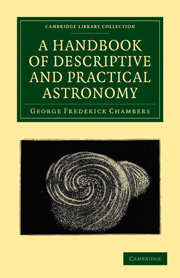Book contents
- Frontmatter
- PREFACE
- SUPPLEMENT
- Contents
- LIST OF ILLUSTRATIONS
- PRINCIPAL AUTHORITIES
- Errata
- A Handbook of Descriptive and Practical Astronomy
- BOOK I A SKETCH OF THE SOLAR SYSTEM
- BOOK II ECLIPSES AND THEIR ASSOCIATED PHENOMENA
- BOOK X METEORIC ASTRONOMY
- APPENDICES
- APPENDIX I The Nomenclature of the Minor Planets
- APPENDIX II A Catalogue of Eclipses
- APPENDIX III A Catalogue of all the Comets whose Orbits have hitherto been computed
- APPENDIX IV A Catalogue of Comets Recorded, but not with sufficient Accuracy to enable their Orbits to be calculated
- APPENDIX V A Catalogue of Stars, Clusters, and Nebulæ which can be observed with greater or less facility in small Telescopes
- APPENDIX VI A Catalogue of Variable Stars
- APPENDIX VII Star Catalogues
- APPENDIX VIII List of Observatories
- INDEX TO SUBJECTS
- INDEX TO NAMES
- Plate section
APPENDIX I - The Nomenclature of the Minor Planets
Published online by Cambridge University Press: 05 July 2011
- Frontmatter
- PREFACE
- SUPPLEMENT
- Contents
- LIST OF ILLUSTRATIONS
- PRINCIPAL AUTHORITIES
- Errata
- A Handbook of Descriptive and Practical Astronomy
- BOOK I A SKETCH OF THE SOLAR SYSTEM
- BOOK II ECLIPSES AND THEIR ASSOCIATED PHENOMENA
- BOOK X METEORIC ASTRONOMY
- APPENDICES
- APPENDIX I The Nomenclature of the Minor Planets
- APPENDIX II A Catalogue of Eclipses
- APPENDIX III A Catalogue of all the Comets whose Orbits have hitherto been computed
- APPENDIX IV A Catalogue of Comets Recorded, but not with sufficient Accuracy to enable their Orbits to be calculated
- APPENDIX V A Catalogue of Stars, Clusters, and Nebulæ which can be observed with greater or less facility in small Telescopes
- APPENDIX VI A Catalogue of Variable Stars
- APPENDIX VII Star Catalogues
- APPENDIX VIII List of Observatories
- INDEX TO SUBJECTS
- INDEX TO NAMES
- Plate section
Summary
This is a subject on which we have a few words to say. In the early days of this branch of astronomical discovery, a sort of understanding was come to by astronomers that the names given to these bodies should as far as possible be those of ancient female divinities. So much for the theory which is unexceptionable. Now for the practice. This is bad in two ways: — 1. The original arrangement is constantly broken through; and 2, sufficient precautions are not taken to choose names, which cannot be mistaken (by reason of similarity of sound) for ones, previously appropriated. With reference to the 1st, we havo nothing particular to say against such names as Parthenope, Massilia, Isis, &c., as they indicate where the discovery wts made, but we most emphatically protest against the fawning servility which prompted such appellations as Eugenia, and Maximiliana, and Angelina. We have the highest opinion of the excellence of the Empress of France, nor do we doubt that King Maximilian of Bavaria has deserved well of his German subjects, but why should they be raised to the skies? In 1813 the Academy of Leipzic proposed to add the name of Napoleon I. to the constellations; astronomers, with much good sense, repudiated the idea. Has the race degenerated? The same remarks apply with equal force to Angelina.
- Type
- Chapter
- Information
- A Handbook of Descriptive and Practical Astronomy , pp. 413 - 414Publisher: Cambridge University PressPrint publication year: 2010First published in: 1861

